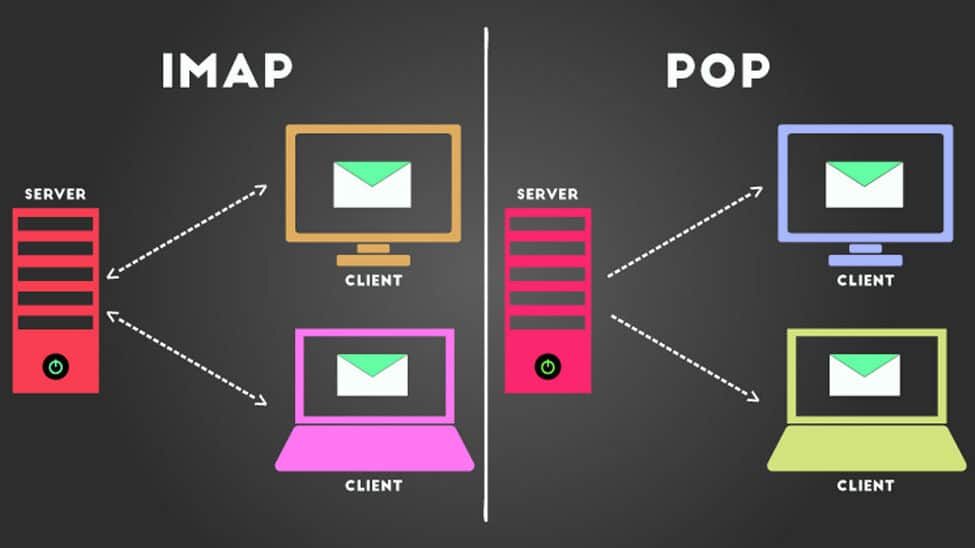If you have ever set up an email client or app, you will have certainly come across the terms POP and IMAP. Do you remember which one you chose and why? If you are not quite sure what these terms stand for and how each affects your email account, we will try to explain it in a plain language. Both POP and IMAP allow you to read your emails using programs, rather than webmail that works through your Internet browser.
What is POP
POP is really old technology and has been in use for over 30 years with minimum improvements. It usually downloads all emails from your mail server to your computer, although you can leave the messages on the server as well. It really isn’t suitable for the modern world anymore, with everyone having several devices!
A typical example of a POP email service is Spark Xtra. Many other Internet providers use it as well. If you are using one for your business – please stop, it’s a bad idea!
POP downloads your emails on one device and it stays there. If another computer, phone or tablet, connects to the same email account, it will download its own copy or nothing at all, depending on whether your server is configured to keep downloaded messages. If you reply to an email, the reply will only be saved to the computer where you typed it on. If you organize your emails into folders, those folders will only be on that computer as well. If your computer dies or you delete the emails, they are gone! You definitely must back up your computer when you use POP.
POP also downloads either all or nothing. If you have a lot of emails and they have attachments, it will take a long time to download them all. Also, if the computer “forgets” it already downloaded the emails (happens with software glitches), it will download the same messages again, and you’ll end up with a lot of duplicates in your Inbox. Not a pretty sight!
The majority of POP based email services also give very little space to email accounts, so you may have something like a 100 MB limit. While this was ok back in the 90s, it’s simply not enough nowadays. You have to manually delete and archive your emails to get a bit of breathing room and it can become quite tedious.
POP is also designed for just emails and not much else. When you save contacts or make calendar appointments, they will only be on your computer, instead of syncing to all of your devices.
Is there anything good about POP? Certainly! Your mail is always stored locally, even if you don’t have an Internet connection. The Internet connection is needed only when you send or receive messages. You can even have the same mailbox for several email accounts.
You can choose POP if you…
- Want to access your mail from only one single device
- Need constant access to your email, regardless of internet availability
- Have limited server storage
What is IMAP
IMAP is a big improvement over POP. Instead of just downloading your emails, it downloads a copy of them and maintains a link between your computer and the email server. Your email server becomes the primary storage for your emails and all other devices just sync with it, meaning your inbox, folders, and sent items will look exactly the same on all of your devices. If you read the message, it will display as read on other devices. If you mark it as spam, it will be marked as spam on all devices as well. If you reply from your phone on the go, you will see the reply on your computer!
It’s still a good idea to backup your emails but even if your computer dies, the emails are still on the server. IMAP email service usually offers more space on the servers but it’s still old technology. It doesn’t support synchronization of your contacts and calendar so many people resort to using 3rd party services, such as iCloud. It can become tricky to troubleshoot when things go wrong and they often do!
Since IMAP constantly syncs email messages, you need to have a really fast and reliable Internet connection. otherwise, you’ll always see “syncing…” and it will be a struggle to use your email, especially if you have a lot of messages and folders.
Choose IMAP if you…
- access your email from multiple different devices
- have a reliable and constant internet connection
- are worried about backing your emails up
Recommendations
The popularity of web-based email (webmail) and services like Gmail / Hotmail / Outlook largely made both POP and IMAP obsolete. However, if you still like checking your email using a desktop email client like Outlook, Thunderbird, Windows Live Mail and many others, you are doing it the way it was done 10 or 20 years ago!
If you are using email service from your providers, such as Xtra, Slingshot, TrustPower and others, we highly recommend that you switch to something more robust, like Gmail or Outlook. These will work no matter what provider you choose to go with.
If you run a business and have your own domain you should consider switching to Office 365 instead.


